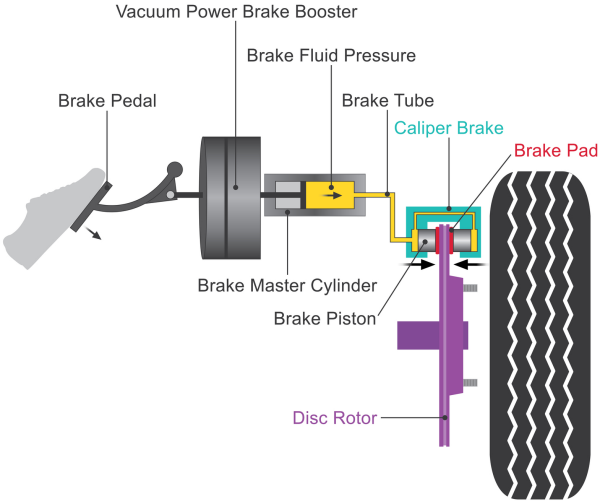Brake Pads, Shoes, Disks, and Drums Replaced
Perhaps the single most critical safety system in your car are the brakes. Routine inspection and maintenance is necessary to maintain safe operation.
Brake Pads

Made from a variety of metals, brake pads squeeze the rotor whenever the brake pedal is pushed. Brake pads typically last between 20,000 and 40,000 miles, perhaps much longer with high quality brake pads.
But even if you aren't watching the odometer closely, brake pads are designed to alert drivers when they're wearing thin. A small metal piece pings or "chirps" when it makes contact against the brake disc. Listen for that squealing, otherwise you could do serious damage to your brakes. Paying attention to and acting on cues like these, help keep routine services from becoming major repairs.
Replace Brake Pads and Rotors, Front Wheel Drive - Starting at $200 plus parts.
Replace Brake Shoes and Drums, Rear Wheels on most vehicles - Starting at $120 plus parts.
Calipers
Part of a disc brake system, calipers push the brake pads against the rotors when the brake pedal is pushed. This resulting friction between the pads and rotors slows and ultimately stops the vehicle.
Waiting too long to replace worn brake rotors puts extra stress on the calipers. The calipers will rub against uneven rotors if the components aren't parallel to one another, creating a vibration that can be felt in the steering wheel during stops.
Replace Calipers and Bleed the system - Starting at $150 plus parts.
Drums
These bowl-shaped components use springs to expand the brake pads against the inside of the drum. This style of brake is typically found on the rear of trucks or sedans. While it produces brake dust, the majority of it hides behind the covering, which means less gunk on your rims.
The brake drum is typically made of cast iron that conducts heat and is resistant to wear. So why are drum brakes usually found on the rear wheels?
Drum brakes are cheaper and take less hydraulic force to activate. When you stop your car most of the braking is done by the front brakes because of weight transfer; why you feel pressed towards the front when you hit the brakes. Drum brakes are more susceptible to warping and brake fade. They're worse at cooling, and more likely to need cleaning and adjustment for optimal operation than disc brakes because a lot of the dust from brake shoes stays inside the drum.
Rotors
As the name implies, these metallic discs rotate as the wheels are in motion. Rotors sit behind the wheel assembly and can sometimes be seen through the vehicle's rims. Pressing the brake pedal activates clamps on both sides of the rotor.
Friction created during braking produces searing heat that eventually scars the rotors. While they can be resurfaced, rotors eventually reach a point where replacement is the only option.
Rotors should be checked during a tire rotation or multipoint inspection.

Haltom City, Texas
Haltom City is an inner suburb of Fort Worth, a principal city of the DFW Metroplex. The city is 6 miles from downtown Fort Worth, 30 miles from the American Airlines Center in Dallas, and 20 miles from the Dallas/Fort Worth International Airport in Irving. Haltom City is surrounded almost entirely by Fort Worth, North Richland Hills, Watauga, and Richland Hills.

 817-204-6283
817-204-6283